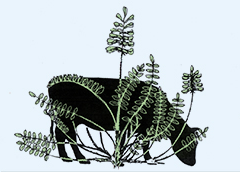Abstract
Death camas (Zigadenus spp) is a perennial forb found throughout the western United States, which is known to kill both sheep and cattle. In a previous study, goats appeared to be somewhat resistant to the adverse effects of death camas. Therefore, the objective of this study was to directly compare the susceptibility of goats and sheep to the acute toxic effects of death camas. Sheep and goats were dosed at 0.5, 1.0, 2.0, 4.0, and 6.0 g death camas per kg BW. The data presented in this manuscript suggest that goats are more susceptible to death camas than sheep. There were no differences in the serum concentrations of zygadenine in sheep versus goats. There was a difference between goats and sheep in the severity of observed clinical signs of poisoning. This is highlighted by the fact that five goats from the two highest doses died, whereas none of the sheep died. Consequently, when grazing goats in death camas infested pastures as much caution, if not more, should be taken than one would with sheep. Additionally, the data presented in the study suggests that goats can be used as a small ruminant model to study the toxic effects of death camas.
Recommended Citation
Welch, Kevin D.; Lee, Stephen T.; Stonecipher, Clint A.; Gardner, Dale R.; and Cook, Daniel
(2024)
"Comparison of Sheep and Goats to the Acute Toxic Effects of Foothill Death Camas,"
Poisonous Plant Research (PPR): Vol. 7, p. 17-26.
DOI: https://doi.org/10.26077/c444-bc12
Available at:
https://digitalcommons.usu.edu/poisonousplantresearch/vol7/iss1/3
Included in
Agriculture Commons, Animal Sciences Commons, Plant Sciences Commons

